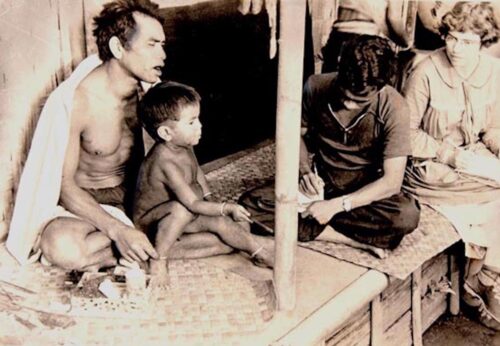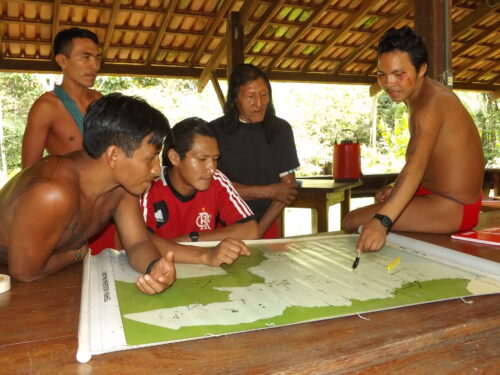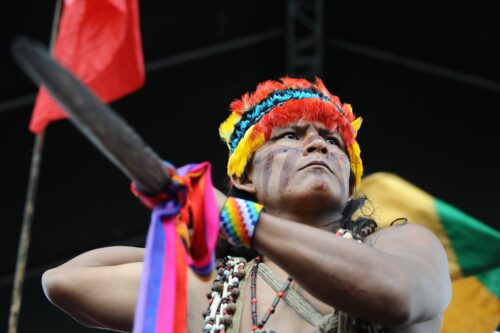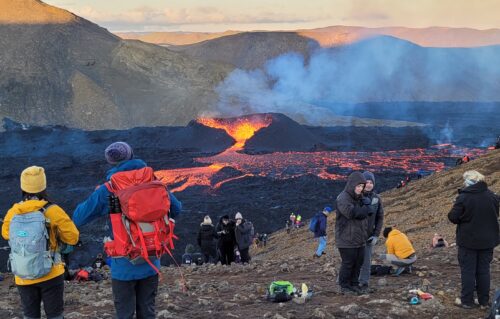Samoan Voices

In this unit (to accompany SAPIENS podcast S6E3), students will compare the different responses of Samoans to Margaret Mead’s work and her publications on American Samoa. Using Mead as a guide, students will examine how “outsider” anthropologists study cultures different from their own and the significance this has on global views of those societies. Students will examine how Samoans, being the “insiders” in their culture, viewed Mead’s outsider perspective and the conclusions she drew. This concept of outsider and insider will be further examined to explain how conclusions made by Western outsiders shaped the global view of non-Western cultures.
- Compare the different responses Samoans had to Margaret Mead’s work.
- Inspect how outsider anthropologists represent the Other and the consequences of this on global views.

Can Anthropology Be Decolonized?

Unsung Native Collaborators in Anthropology

Desvendando a arqueologia do império americano no Panamá

Encontrar pegadas deixadas no início dos tempos

Solucionando o quebra-cabeça das torres antigas de Omã

A digitalização de lápides pode salvar a história?

Desvendando a arqueologia do império americano no Panamá

A ascensão das tias na política paquistanesa

Para as famílias de entes queridos desaparecidos, as investigações forenses nem sempre trazem uma conclusão

Lendo o futuro de uma mina na Amazônia

Para as famílias de entes queridos desaparecidos, as investigações forenses nem sempre trazem uma conclusão

Solucionando o quebra-cabeça das torres antigas de Omã

Morte lenta por vulcão
-
An approach where an anthropologist studies a culture from inside the culture; also known as the insider perspective.
-
An approach where an anthropologist studies a culture from outside the culture; also known as the outsider perspective.
-
Meaning “many voices”; an approach in anthropology that emphasizes the voices of experts from different ethnicities, genders, classes, etc.
- Mead asked, “Are the disturbances which vex our adolescents due to the nature of adolescence itself or to the civilization? Under different conditions, does adolescence present a different picture?” Discuss the conclusions Mead drew based on these questions. Ask students if they believe the “disturbances” are because of nature or civilization and to expand on their answers.
- Many Samoans have not read Mead’s or Derek Freeman’s writings, yet they have opinions on the conclusions of both anthropologists. Discuss why some Samoans may be unfamiliar with these works, and why others may have chosen to not read them. More broadly, discuss the problems of drawing conclusions based on hearsay.
- Discuss the problems of categorizing a culture based on an outsider’s writing about the culture and compare Mead’s and Freeman’s conclusions and the methods they used to reach them.
- Many Samoans rejected Mead’s conclusions and were upset after hearing what was written about them. Mead wrote about what she saw as less restrictive attitudes around sex and sexual conduct in American Samoa compared with those in Western cultures. Some Samoans argued that Mead neglected to examine the ceremonial importance of virginity in some sectors of Samoan society. Discuss how two opposite claims can be made about the same culture. Discuss how being an insider (emic) or an outsider (etic) can influence perspective.
- Both Mead and Freeman used Samoan society as the basis for their research, but the voices of native Samoans were missing from the debate. Based on chapter nine in Paul Shankman’s 2009 book The Trashing of Margaret Mead and the SAPIENS podcast on Mead, discuss some of the reactions by Samoans to the anthropologists’ works and how they categorize adolescence and the adolescent experience on their island.
-
Miller, Daniel. 2020. “How Can Anthropological Research Impact the Populations It Studies? Six Steps for Creating Inclusivity and Accessibility with Ethnographic Monographs.” Impact of Social Sciences (blog), August 18.
-
Naaeke, Anthony, Anastacia Kurylo, Michael Grabowski, David Linton, and Marie Radford. 2011. “Insider and Outsider Perspective in Ethnographic Research” Proceedings of the New York State Communication Association 2010 (9).
-
Pink, Sarah, and Vaike Fors. 2017. “Ethnography, Stakeholders, and Audiences: Toward Openness and Inclusivity.” Sociological Research Online 22 (4): 169–173.
-
Shankman, Paul. 1996. “The History of Samoan Sexual Conduct and the Mead–Freeman Controversy.” American Anthropologist 98 (3): 555–567.
- What does it mean to be an outsider anthropologist? What are the benefits of an outsider anthropologist studying another culture? What are the disadvantages?
- How did Samoan people react to Mead’s published work?
- How has Mead’s work and writing influenced the West’s view on Samoa and the Samoan people?
- Who gets to tell the story of a people? Whose voices are elevated, and whose are often buried? What effect does that have on the story?
- Create a Venn diagram to compare at least two Samoan responses to Mead’s writing.
- Create a trifold to compare three Samoan responses to Mead’s work.
- Write an essay comparing Mead’s ideas with the Samoan people’s response to her ideas.
- Who should tell the story? Write an argumentative essay explaining who should write about a culture and why. Explain the perspective of an outsider anthropologist and discuss why you think they should or should not be the one writing about a culture different from their own.
- Describe how Samoan culture was viewed globally based on anthropological research about it. Include Mead’s perspective.
-
Article: New York Times’ “Samoan Leader Declares ‘Both Anthropologists are Wrong’”
-
Book: Paul Shankman’s The Trashing of Margaret Mead
-
Exhibition: Library of Congress’ Margaret Mead: Human Nature and the Power of Culture
Jasmine Rubel, Freedom Learning Group
Positioning the Anthropologist
